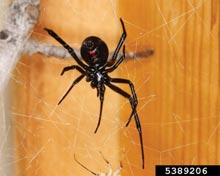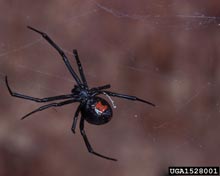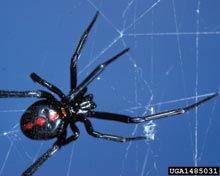
Joseph Berger

Sturgis McKeever, Georgia Southern University

Sturgis McKeever, Georgia Southern University
Black Widow Spiders
General Description
Adult female widow spiders have bodies up to one-half of an inch long. Much smaller are the male black widows
and immature females that are gray to brown with spots and stripes of red, orange and/or yellow on the upper
surface of their abdomens. Thus not all widow spiders are black. But in the United States, adult females of the
three most common widows are almost always a shiny black. The familiar “hourglass” marking located on the underside
of the female’s bulb-shaped abdomen is bright red or red-orange. In northern black widows (Latrodectus
variolus), the upper and lower halves of the hourglass are separated into two red spots, while the marking on the
southern black widow (L. mactans) is represented by a single, red, hourglass-shaped mark. There is, however,
considerable variation among individual widow spiders. Some have no hourglass markings. Most have a smaller
red spot near the tip of the abdomen. There may be a line of red spots on the upper side of the abdomen, and
northern widows often have white streaks on the sides of their abdomens.
General Control
Controlling black widow spiders also involves inspecting structures and outdoor areas for the presence of the spiders
and their webs. This is best done at night because black widows hide during the day and hang in their webs
at night. Like other cobweb spiders, black widows can be dispatched by vacuuming, if care is taken not to release
the spiders when emptying the vacuum cleaner. Smashing them with fly swatters, boards and shoes will work as
the spiders are not aggressive and cannot run away fast. Treating them directly with a contact pesticide is another
option. Lastly, applications of residual pesticides, such as wettable powders or encapsulates, to crawlspaces and
around foundations also can deter these and other types of spiders.









